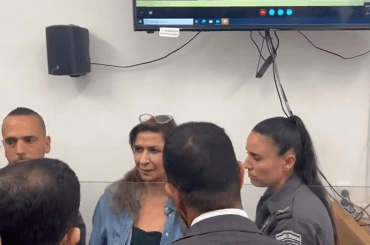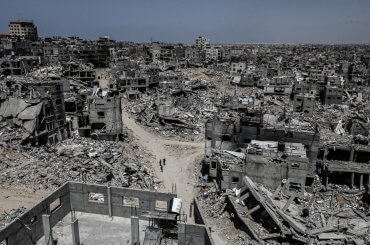I stood beside three journalists on a small mound and gazed helplessly across at the demolition of the Palestinian-Bedouin village of Umm al-Hiran, a village located in the Naqab/Negev region of southern Israel. It’s Wednesday, 18th January, 2017. The village is undergoing demolition to make way for the new, Jewish town of Hiran, which will inherit the name, as well as the location of the village, to which this group of Palestinian-Bedouins were relocated by the Israeli State in 1956. Along with a group of other activists, I arrived before dawn at 5:15 AM, a mere 15 minutes before nearly a thousand heavily-armed, gun-wielding policemen stormed into the village.
My surroundings became a valiant re-rehearsal of Alfred, Lord Tennyson’s, Charge of the Light Brigade, a classic of British high-school (poetry) propaganda, about the honor of dying for one’s nation. I heard the words echo:
Theirs not to reason why,
Theirs but to do and die.

A never-ending convoy of SUVs accompanied the footmen who ran full-pelt into the village. The convoy of vehicles stretched up the hill and along the road out towards the main highway. Headlights glistened, as far as the eye could see. A truly awesome display of might. The message was really being driven home: the state has power at its disposal. There were even proverbial fireworks to accompany the show (I’m referring here to the abundance of smoke and light grenades that were fired, perhaps for dramatic effect). It seemed that almost everything the state has on offer within its arsenal was being exhibited. I understood, firsthand, what it means to hold the monopoly of violence.
Later, policemen riding horses were brought in to compound the Tennysonian impression. The police’s leadership even built a tent on a nearby hill, from where they too, could admire the might of their men. Does adding the tent to the rendition produce an account more reminiscent of Roman Empire style furore?
As the policemen charged past, the inevitable gunfire began. It was still dark and there was a lot of tear gas being dealt out. There was chaos and the incessant, single, mournful drone of a car horn that seemed to sound on for eternity. Rumors were that a dead man was slumped forward on his car horn. This only made the sound less bearable.
Together with an equally bleary-eyed Bedouin family, I was quickly escorted to a perimeter the police had established to create a “sterile zone” for the demolition. Amidst a deluge of tear gas strewn faces and rumors of death, police threatened and shoved villagers and activists. The sun’s first rays started to touch the scene.
Not long afterwards, one of the journalists checked her phone. “They’re reporting it as a car attack by a Jihadist linked to Daesh” she told us. Another journalist responded: “they came to kill. Did you not see them? How are they surprised someone was killed? They came to kill.” The verdict is quickly established that if the police are giving witness, so must we. One of the journalists, Keren Manor, pulled out her phone. There’s no time for high quality footage now. There is an urgent sense that this needs to “get out there.” Kobi Snitz, one of the eye witnesses, agreed to testify in a video, that goes instantly viral. The immediacy of the temporal capacity and expectation of the digital age is dazzling and overwhelming. We needed to make the truth public and fast. “Every story has two sides” goes the truism. “It’s important that the truth be heard” responds the legal mind. But what does all this mean in the era of post-truth?
If post-truth is really about “relating to or denoting circumstances in which objective facts are less influential in shaping public opinion than appeals to emotion and personal belief,” we must reconsider carefully the power of activism.
The cynic might notice that the witnesses that came forward were Ashkenazi Jews. The pragmatist proposes that the role of activist-witness is evermore important. “We came to bear witness” an American girl told me. She was clearly stunned by the spectacle she has just been exposed to. (I guess she has also spent the time since Wednesday in shock: vomiting, sleeping or eating, depending on her body’s capacity to respond).
I was torn between the urge to dismiss her remark as naive fanfare, and the need for a last shred of purpose in this cacophony of confusion and contradiction. This event is starting to feel a lot like post-truth, beyond the proverbial.
As activists, we were unprepared against the backdrop of the beautifully choreographed display of force we were confronted with. I feel embarrassed, outraged and disappointed.
Condemned to watch from a nearby mound, I consider the failure of the left. We don’t even have enough water or back-up batteries for our mobile phones! I quickly recognize that the blame game changes nothing. Against such a precisely planned and executed police operation, what can be done? Posting blurry videos to Facebook through intermittent internet signal, already shared by two phones and a laptop just doesn’t feel like enough when seven bulldozers work simultaneously in three different parts of the village. We’re condemned to stand and watch. Clearly, the blurry video of Snitz was important, albeit within a relatively limited temporal and spatial radius. This imaging of the counter-narrative became instantly powerful. What is important now, politically at least, is what the court will rule when the investigation is complete. We might be in the era of post-truth politically, but what are the legal implications of this condition?
Less than 48 hours after the events, a team at the Forensic Architecture agency based at Goldsmith’s in London publishes a video of preliminary findings from a compilation of footage produced by an activist/photographer present at the scene, and an aerial video released by police. The evidence is stunning. Feminist theory has long talked about what comes to count as knowledge, and the privilege of the partial perspective. What the Forensic Architecture piece potentially does for us, is to join the dots between the local, partial perspective – blurry, unstable, incomplete, perhaps even incoherent – with the language that was, at least until now, the language of authority and power: metadata, the view-from-nowhere of aerial imagery and the Trump-card of expertise (excuse the reference but this is central if we are indeed in the era of post-truth).
The aerial video shows that the car was moving slowly at first when three shots were fired in its direction. This suggests that the driver may have already been dead when the car careered down the hill, hitting a police officer. Another mantra muttered in the mayhem, suggests that you cannot so easily die from being hit by a car and that the police officer was shot in the dark by another policeman, just like the “so-called” terrorist.
Making terrorists out of your own citizens, it doesn’t seem like a smart move to me, whichever way you look at it. Having worked in the Naqab-Negev region on and off for nearly 5 years now, I can say that more than a terrorist population, these Palestinian Citizens of Israel, are some of the most oppressed and marginalized groups in the country. For once, I agree with Netanyahu: the Bedouin public are not the enemy but part of the fabric of Israeli society (as long as there is such a thing).
All this begs the question about how evidence is constructed, whether legal, media or otherwise? What and who has the power and authority to produce and present evidence? What can we learn from the fact that the witnesses that came forward for social media testimonies were Ashkenazi Jews? How can we use our positionality to form powerful assemblages with those we seek to defend? There were evidently plenty of Palestinian-Bedouins present who also saw and heard Yaqub Musa Abu al-Qi’an be shot before his car started rolling, uncontrollably, down the hill. Power and privilege obviously come into it, but there is so much more to what counts as evidence in the era of post-truth, and this has everything to do with the pragmatics of activism at such a Trumpeting time.
This post first appeared on Palestine Square, a site for the Institute for Palestine Studies.



What can we learn from the fact that the witnesses that came forward for social media testimonies were Ashkenazi Jews? How can we use our positionality to form powerful assemblages with those we seek to defend?
this article was excellent testimony. to answer your second question , form powerful assemblages by a. putting palestinian voices first, by b. when possible, communicate in one voice.
when i woke up (relatively) late on thursday morning in california, given who i follow, my twitter was a deluge of tweets w/photos /video about Umm al-Hiran. i RT’d some of them. but it wasn’t until i opened and read adalah’s tweet that i realized:
“Eyewitnesses confirm Ya’akub Musa Abu Al-Qi’an lost control of car after police fired at him.”
so i tweeted that out along w/adalah’s tweet (7 am calif time) https://twitter.com/anniefofani/status/821735059929477120
my tweet got 15 RT’s which is really a lot for me and it got picked up by people with a much larger following than me (this indicated to me many people, like me, were not previously aware of the info in the quote i picked up from adalah’s article). and aside from that quoted (above), which was not the adalah headline, it also said this:
iow, the witnesses that came forward for social media testimonies were not all Ashkenazi Jews. Adalah was there. they brought forth the voice and testimony of both villagers and activists, clearly, definitively and equally. also included:
they also included a photos from the All That’s Left Collective. a collective of Palestinians and Jews. i recommend their full account:
https://www.adalah.org/en/content/view/9001
Reminds me of the latest hot button issue on US main media re Trump vs The Establishment:: “Alternative facts.”
… activism in the post-truth era
————–
Ah, the era of truth. How I mourn its passing!
(When was that era, btw?)